Fishes, Amphibians, and Reptiles -> vertebrates
Vertebrates
Vertebrates are animals that have a backbone or vertebral column. This group of animals is characterized by the presence of a well-developed internal skeleton made of bone or cartilage. Vertebrates are found in various habitats, including the ocean, freshwater, and on land. They are also known for their diverse range of adaptations, behaviors, and lifestyles.
Characteristics of Vertebrates
Vertebrates share several key characteristics, including:
- Backbone: Vertebrates have a well-defined vertebral column that provides support and protection for the spinal cord.
- Internal Skeleton: Their internal skeleton is composed of bone or cartilage, providing structure and support for the body.
- Nervous System: Vertebrates have a complex nervous system with a brain and spinal cord, allowing for coordination of body functions and responses to the environment.
- Bilateral Symmetry: Most vertebrates exhibit bilateral symmetry, meaning their bodies can be divided into two equal halves.
- Well-Developed Sensory Organs: They possess well-developed sensory organs such as eyes, ears, and a keen sense of smell, which aid in their survival and interactions with the environment.
Classification of Vertebrates
Vertebrates are classified into five main groups:
- Fish: This group includes jawless fish, cartilaginous fish, and bony fish. They are cold-blooded and typically live in water.
- Amphibians: These animals undergo metamorphosis from aquatic larvae to terrestrial adults. They have moist skin and typically lay eggs in water.
- Reptiles: Reptiles are characterized by their scaly skin and ability to lay shelled eggs on land. They are cold-blooded and include snakes, lizards, turtles, and crocodiles.
- Birds: Birds have feathers, lay hard-shelled eggs, and are warm-blooded. They are adapted for flight and have a unique respiratory system.
- Mammals: Mammals are characterized by the presence of mammary glands for feeding their young, hair or fur, and a unique middle ear bone structure. They are warm-blooded and give birth to live young.
Study Guide
To study vertebrates effectively, consider the following key points:
- Understand the defining characteristics of vertebrates, including the presence of a backbone and internal skeleton.
- Learn about the classification of vertebrates and the key features that distinguish each group.
- Explore the adaptations and behaviors of vertebrates in different habitats, such as marine, freshwater, and terrestrial environments.
- Compare and contrast the reproductive strategies of vertebrates, including egg-laying and live birth.
- Examine the diverse sensory adaptations of vertebrates and their significance in their survival and ecological roles.
By mastering these concepts, you can gain a comprehensive understanding of vertebrates and their importance in the natural world.
[Vertebrates] Related Worksheets and Study Guides:
.◂Science Worksheets and Study Guides Sixth Grade. Fishes, Amphibians, and Reptiles
Study Guide Fishes, Amphibians, and Reptiles
Fishes, Amphibians, and Reptiles  Activity Lesson
Activity Lesson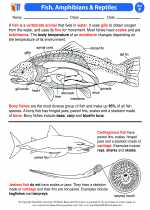 Fish, Amphibians & Reptiles
Fish, Amphibians & Reptiles  Worksheet/Answer key
Worksheet/Answer key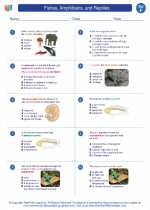 Fishes, Amphibians, and Reptiles
Fishes, Amphibians, and Reptiles  Worksheet/Answer key
Worksheet/Answer key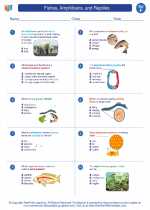 Fishes, Amphibians, and Reptiles
Fishes, Amphibians, and Reptiles  Worksheet/Answer key
Worksheet/Answer key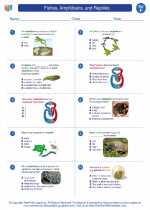 Fishes, Amphibians, and Reptiles
Fishes, Amphibians, and Reptiles  Worksheet/Answer key
Worksheet/Answer key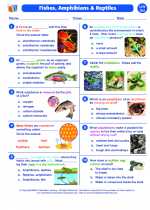 Fishes, Amphibians, and Reptiles
Fishes, Amphibians, and Reptiles  Vocabulary/Answer key
Vocabulary/Answer key Fishes, Amphibians, and Reptiles
Fishes, Amphibians, and Reptiles  Vocabulary/Answer key
Vocabulary/Answer key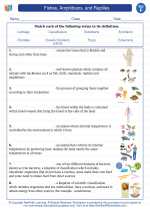 Fishes, Amphibians, and Reptiles
Fishes, Amphibians, and Reptiles  Vocabulary/Answer key
Vocabulary/Answer key Fishes, Amphibians, and Reptiles
Fishes, Amphibians, and Reptiles  Vocabulary/Answer key
Vocabulary/Answer key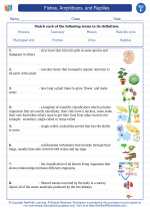 Fishes, Amphibians, and Reptiles
Fishes, Amphibians, and Reptiles  Vocabulary/Answer key
Vocabulary/Answer key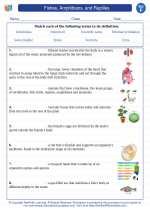 Fishes, Amphibians, and Reptiles
Fishes, Amphibians, and Reptiles 

 Activity Lesson
Activity Lesson
 Worksheet/Answer key
Worksheet/Answer key
 Worksheet/Answer key
Worksheet/Answer key
 Worksheet/Answer key
Worksheet/Answer key
 Worksheet/Answer key
Worksheet/Answer key
 Vocabulary/Answer key
Vocabulary/Answer key
 Vocabulary/Answer key
Vocabulary/Answer key
 Vocabulary/Answer key
Vocabulary/Answer key
 Vocabulary/Answer key
Vocabulary/Answer key
 Vocabulary/Answer key
Vocabulary/Answer key

The resources above cover the following skills:
LIFE SCIENCE
From Molecules to Organisms: Structures and Processes